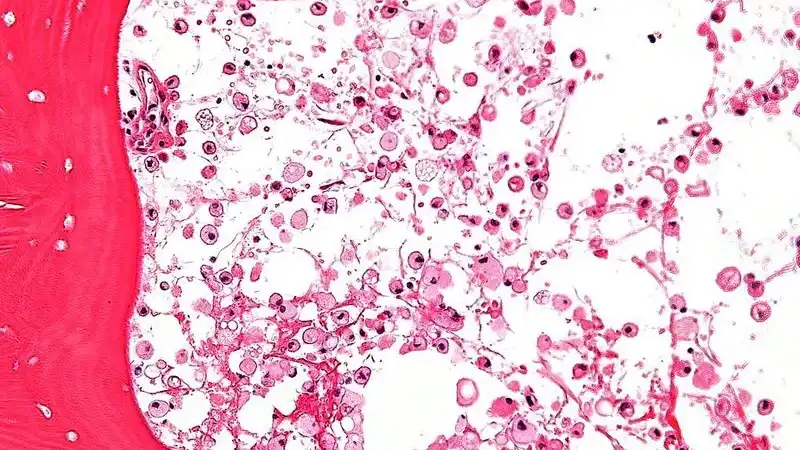Gaucher Disease


What is Gaucher Disease
Gaucher disease is a genetic disorder caused by changes in the GBA gene that affect the body’s ability to break down a substance found in cell membranes. This substance accumulates in the liver, spleen, and bone marrow, leading to a wide range of symptoms. There are multiple types of Gaucher disease described below. Treatments can help with many of the symptoms.
Type 1
Type 1 Gaucher disease is the most common form, with a range of symptoms that can onset
from childhood to late adulthood.
Symptoms include bone pain, low bone density, and an increased risk for broken bones. People with type 1 Gaucher disease often have an enlarged liver and spleen, as well as a lowered number of red blood cells and platelets (anemia). This can lead to the person feeling tired and weak, and more likely to have bruising and excess bleeding.
Type 1 is distinct from other forms of Gaucher disease because it usually does not affect the individual’s brain or spinal cord.
Type 2
Type 2 Gaucher disease causes neurological symptoms in addition to the common features of type 1 Gaucher disease. Symptoms of type 2 Gaucher disease usually appear before age 2 and progress rapidly. Neurological symptoms of type 2 Gaucher disease can include limited cognitive and motor development, breathing problems and difficulty swallowing, and tightening of the muscles. As the nervous system deteriorates, children with type 2 Gaucher may develop dementia and the inability to coordinate movement.
Type 3
People with type 3 Gaucher disease have the symptoms of types 1 and 2 Gaucher disease; however, symptoms progress more slowly than the symptoms of type 2 Gaucher disease.
Perinatal-Lethal Form
The perinatal-lethal form is a severe form of Gaucher disease which usually leads to death of a developing fetus or shortly after birth. Infants with this form of Gaucher disease have symptoms including enlarged liver and spleen, lowered number red blood cells and platelets, neurological problems, skin abnormalities, and distinct facial features.
Cardiovascular Form
The cardiovascular form of Gaucher disease causes symptoms involving the heart. Specifically, there is a hardening of the heart valves, an enlarged liver and spleen, bone problems including pain, fractures, and arthritis, as well as difficulty controlling eye movement and a clouding of the eye’s cornea, which can affect vision.
How Common is Gaucher Disease?
Type 1 Gaucher disease is the most common form of this disease. This type is particularly
prevalent among people of Ashkenazi Jewish descent; approximately 1 in 800 is affected by the disease and 1 in 14 is a carrier. Other forms of Gaucher disease are rare.
How does Gaucher disease inheritance work?
Gaucher disease is a recessive genetic disorder, meaning it occurs when a child has no working copies of the GBA gene. Typically, people have two working copies of each gene. When a child has Gaucher disease, both of their parents are typically carriers, each having only a single working copy of the GBA gene. Carriers do not show symptoms of the disease, but they do have a slightly higher chance of developing Parkinson disease later in life. When two carriers have a child, there is a 25% chance that the child will inherit no working copies of the gene, leading to Gaucher disease. There is a 50% chance that the child will be a carrier like the parents and a 25% chance that the child will inherit two working copies of the gene.
Why do genetic testing for Gaucher disease?
Genetic testing plays a critical role in diagnosing Gaucher disease and finding carriers. Early
diagnosis allows for quicker access to treatments that can slow down the disease’s progression. Also, genetic testing is vital for family planning, as finding carriers can help prospective parents make informed decisions and seek medical advice if they plan to have children.
How is Gaucher Disease Treated?
Gaucher disease is treated through enzyme replacement therapy (ERT). ERT is given by
infusion twice a month and helps stop the buildup of the substances that would accumulate in the body in a person with Gaucher disease. ERT is effective in treating disease symptoms and preventing bone and organ damage. ERT does not treat the neurological symptoms found in types 2 and 3. People with the cardiovascular form of Gaucher disease often need heart valve replacements. Other treatments for the symptoms of Gaucher disease include blood transfusions for tiredness and excessive bleeding, joint replacement to relieve pain and restore movement, and medication to treat bone pain.
What is the prognosis for a person with Gaucher Disease?
The prognosis for a person with Gaucher disease varies depending on the type of Gaucher
disease, the onset and severity of symptoms, and the availability of treatment.
With treatment, those with type 1 Gaucher disease are expected to have a normal lifespan.
Individuals with severe cases of type 1 Gaucher may have symptoms that are more difficult to
manage.
Those with type 2 Gaucher disease often have significant delays and may die between the ages of 2 and 4. In the most severe type 2 cases, death may occur before or shortly after birth.
Those with type 3 Gaucher disease usually develop symptoms in childhood which slowly worsen over time. While some people have died in childhood, others have lived into their 30s and 40s.
Those with the perinatal-lethal form of Gaucher disease often die before or shortly after birth.
The prognosis for those with the cardiovascular form of Gaucher disease depends on the
success of valve replacement surgery and treatment of other symptoms.
Resources
- MedlinePlus for Gaucher disease
A resource created by the NIH National Library of Medicine that provides information about the disease, frequency, inheritance, and other information and resources.
- National Gaucher Foundation
A non-profit that promotes research, education, and awareness for Gaucher disease and supports patients with the disease and their families.
800-504-3189
